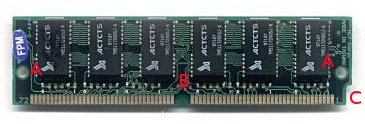All about memory
|
This page has been migrated to a document on Free Geek's Google Drive. Information remaining behind may no longer be relevant. MIGRATOR: When you have tagged this page as migrated, (Link to new page immediately below.) |
OBJECTIVE To enable the builder to recognize and install memory sticks on the motherboard
RAM (or Random Access Memory) is an important part of the computer system which is used by actively running programs to perform necessary tasks while the computer is on. It is composed of integrated circuit memory chips that allow information to be stored or accessed in any order and all storage locations are equally accessible. The information on RAM can be tossed out to make more space, as opposed to the Hard Disk Drive where the computer stores information for the long haul.
Memory sticks
- RAM or Random Access Memory comes in 2 types, DIMM and SIMM
- DIMM (Dual In-Line Memory Module)
- DIMMs are usually 5.25" long and plug into slots that have plastics clips at the end that open and close to hold them in. There is also a type of DIMM that is only 2.5-2.75" long known as SODimm which is used in laptops and small computer systems
- SIMM (Single In-Line Memory Module)
- SIMM is the oldest form of memory that we still see and is shorter than the currently-used types - generally 4.25" long or 3.5" long. Its slots on the motherboard have metal clamps at the end to hold the stick in place.
Exercise Find the SIMM and DIMM slots on the motherboards on the example board in front of you so you can identify these slots.
DDR
A stick of DDR has a single notch in it near the center of the stick, with gold pins missing from one side more than the other, as well as 2 rounded notches on each side
Un módulo de DDR tiene una muesca en en el centro del módulo.
DDR2
The newer DDR2 has a single notch that is slightly nearer the center of the stick, so it will not fit into a regular DDR slot. That notch also has symmetrical missing gold pins on either side. Like DDR, there are 2 rounded notches on the sides of the stick as well.
DDR3
The DDR3 stick also has a single notch on it that is slightly closer to the end than the DDR2, with symmetrical missing gold pins. On the sides, there are square notches as opposed to the rounded ones of DDR and DDR2.
RAMBUS
A stick of RAMBUS has two close together notches at the center of the stick with a very large gap of missing gold pins.
SDRAM
A stick of SDRAM has two notches in it, one near the center of the stick, and one closer to the side.
Un módulo de SDRAM tiene dos muescas, una cerca del centro del módulo, y otra cerca a un extremo del módulo.
72-Pin SIMM
72 pin SIMMs are 4.25 inches long. The holes and notches need to match exactly since there are other objects that look like 72-pin SIMM but aren't, so see points A (side holes), B (center notch) and C (side notch) in the picture.
30-Pin SIMM
30-pin SIMMs are 3.5 inches long. These are the oldest types of memory we still see on a regular basis in System Evaluation. Note that they do not have a center notch.
Exercise 1:
Look at the example memory sticks and match them up with the following pictures and descriptions. Then,
Exercise 2: Try putting the sticks into their slots on the motherboard. Open the clips, match up the notches and install the stick into the grooves at either end. Press down on the stick until the clips flip closed by themselves around the stick. This tells you that the memory is properly seated into the slot so it can function correctly. IMPORTANT - YOU CAN RUIN THE RAM AND FRY THE MOTHERBOARD IF YOU DON'T DO THIS!!!







